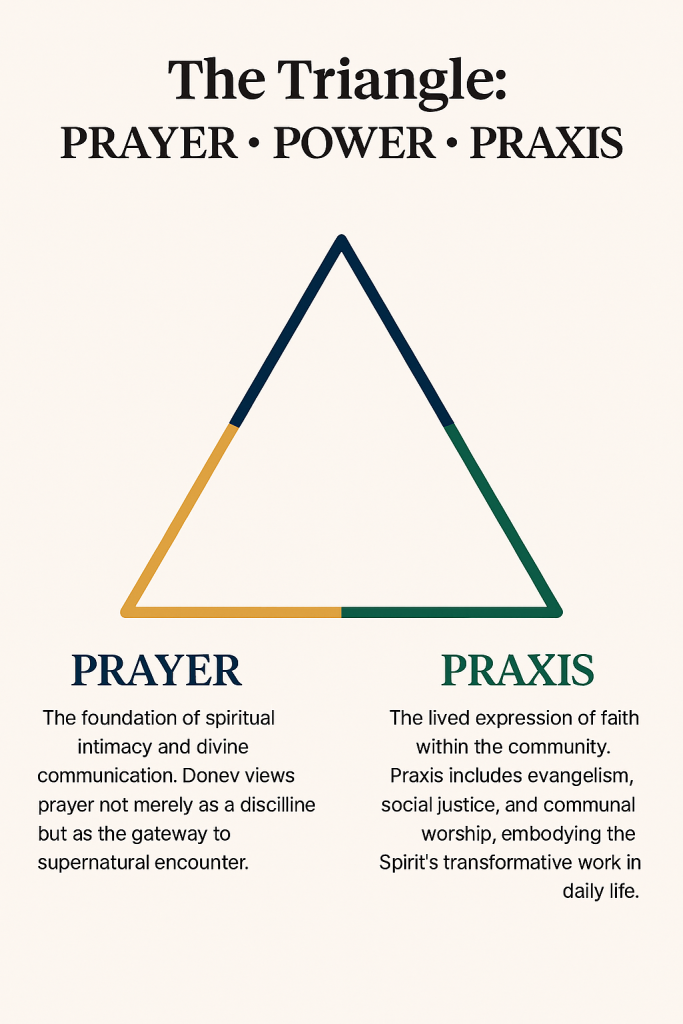Pentecostal Triangle of Primitive Faith: A Framework of Experience and Restoration
Pentecostal Triangle of Primitive Faith
This is one of Donev’s most recognized frameworks. It emphasizes three core elements of Pentecostal spirituality:
- Prayer: Seen as the starting point of spiritual communication and personal experience with God.
- Power: The manifestation of divine presence through spiritual gifts and supernatural experiences.
- Praxis: The lived expression of faith within the community, reflecting both personal and collective identity.
This triangle encapsulates the holistic nature of Pentecostalism, where theology is deeply rooted in experience rather than abstract doctrine.
Restorationist Theology
Donev builds on the idea of primitivism—a return to the faith and practices of the early church. He critiques Wesleyan frameworks like the quadrilateral (Scripture, tradition, reason, experience) as insufficient for Pentecostal identity, arguing that Pentecostalism goes beyond Wesley to reclaim the apostolic era.
Historical-Theological Contributions
In his book The Unforgotten, Donev explores the theological roots of Pentecostalism in Bulgaria, tracing its development through key figures like Ivan Voronaev and the influence of Azusa Street missionaries. His research highlights:
- Trinitarian theology among early Bulgarian Pentecostals, shaped by Eastern Orthodox pneumatology and Western Pentecostal doctrine.
- Free will theology, emphasizing Armenian views over Calvinist predestination, due to Bulgaria’s Orthodox heritage and missionary influences.
Other Notable Works
- The Life and Ministry of Rev. Ivan Voronaev: A historical-theological study of one of the pioneers of Slavic Pentecostalism.
- Doctrine of the Trinity among Early Bulgarian Pentecostals: Explores how the Trinity was experienced and understood in early Eastern European Pentecostal context
The Pentecostal Triangle of Primitive Faith: A Framework of Experience and Restoration
Introduction
Pentecostal theology has long emphasized the experiential dimension of faith—where divine encounter, spiritual gifts, and communal expression converge. Among the contemporary voices shaping this discourse, Dony K. Donev offers a compelling framework known as the Pentecostal Triangle of Primitive Faith, which seeks to restore the apostolic essence of early Christianity. This essay explores the theological contours of Donev’s model and compares it with other influential Pentecostal and charismatic paradigms.
The Triangle: Prayer, Power, Praxis
At the heart of Donev’s framework lies a triadic structure:
- Prayer: The foundation of spiritual intimacy and divine communication. Donev views prayer not merely as a discipline but as the gateway to supernatural encounter.
- Power: Manifested through the gifts of the Spirit—healing, prophecy, tongues, and miracles. This element reflects the Pentecostal emphasis on dunamis, the Greek term for divine power.
- Praxis: The lived expression of faith within the community. Praxis includes evangelism, social justice, and communal worship, embodying the Spirit’s transformative work in daily life.
This triangle is not hierarchical but interdependent. Prayer leads to power, power fuels praxis, and praxis deepens prayer. Donev’s model thus reflects a restorationist impulse, aiming to recover the vibrancy of the early church as seen in Acts.
Comparison with Wesleyan Quadrilateral
The Wesleyan Quadrilateral—Scripture, tradition, reason, and experience—has historically shaped Methodist and Holiness theology. Pentecostals have often adopted this model, emphasizing experience as a key source of theological reflection.
However, Donev critiques this framework as insufficient for Pentecostal identity. He argues that Pentecostalism is not merely an extension of Wesleyanism but a distinct restoration movement. While Wesley’s model is epistemological, Donev’s triangle is ontological and missional, rooted in being and doing rather than knowing.
Comparison with Classical Pentecostal Theology
Classical Pentecostalism, as shaped by early 20th-century leaders like Charles Parham and William Seymour, emphasized:
- Initial evidence doctrine: Speaking in tongues as proof of Spirit baptism.
- Dispensational eschatology: A belief in imminent rapture and end-times urgency.
- Holiness ethics: A call to moral purity and separation from the world.
Donev’s framework diverges by focusing less on doctrinal distinctives and more on spiritual vitality and historical continuity. His emphasis on praxis aligns with newer Pentecostal movements that prioritize social engagement and global mission.
Comparison with Charismatic Theology
Charismatic theology, especially within mainline and evangelical churches, often emphasizes:
- Renewal within existing traditions
- Broad acceptance of spiritual gifts
- Less emphasis on tongues as initial evidence
Donev’s triangle shares the Charismatic focus on spiritual gifts but retains a Pentecostal distinctiveness through its restorationist lens. He seeks not just renewal but recovery of primitive faith, making his model more radical in its ecclesiological implications.
Eastern European Context and Trinitarian Theology
Donev’s work is also shaped by his Bulgarian heritage. He highlights how early Bulgarian Pentecostals embraced a Trinitarian theology informed by Eastern Orthodox pneumatology. This contrasts with Western Pentecostalism’s often fragmented view of the Spirit.
His emphasis on free will theology—influenced by Arminianism and Orthodox thought—also sets his framework apart from Calvinist-leaning Charismatic circles.
Conclusion
Dony K. Donev’s Pentecostal Triangle of Primitive Faith offers a rich, experiential, and historically grounded model for understanding Pentecostal spirituality. By centering prayer, power, and praxis, Donev reclaims the apostolic fervor of the early church while challenging existing theological paradigms. His framework stands as a bridge between classical Pentecostalism, Charismatic renewal, and Eastern Christian traditions—inviting believers into a deeper, more dynamic walk with the Spirit.
Comparative Insights from Leading Pentecostal Scholars
Gordon Fee: Scripture-Centered Pneumatology
Fee’s scholarship emphasizes the Spirit’s role in New Testament theology, particularly in Pauline writings. While he critiques traditional Pentecostal doctrines like initial evidence, he affirms the Spirit’s transformative presence. Compared to Donev, Fee’s approach is exegetical and text-driven, whereas Donev’s triangle is experiential and restorationist, prioritizing lived encounter over doctrinal precision.
Stanley M. Horton: Doctrinal Clarity and Holiness
Horton’s work, especially in Bible Doctrines, provides a systematic articulation of Pentecostal beliefs, including Spirit baptism and sanctification. His theology is deeply rooted in Assemblies of God tradition. Donev diverges by de-emphasizing denominational boundaries, focusing instead on the primitive church’s egalitarian and Spirit-led ethos.
Craig Keener: Charismatic Experience and Historical Context
Keener bridges academic rigor with charismatic openness, especially in his work on miracles and Acts. His emphasis on historical plausibility and global charismatic phenomena aligns with Donev’s praxis-driven model. However, Keener’s scholarship is more apologetic and evidential, while Donev’s triangle is formational and communal.
Frank Macchia: Spirit Baptism and Trinitarian Theology
Macchia’s theology centers on Spirit baptism as a metaphor for inclusion and transformation, often framed within Trinitarian and sacramental lenses. Donev shares Macchia’s Trinitarian depth, especially in Eastern European contexts, but leans more toward neo-primitivism and ecclesial simplicity.
Vinson Synan: Historical Continuity and Global Pentecostalism
Synan’s historical work traces Pentecostalism’s roots and global expansion. Donev builds on this by reclaiming Eastern European Pentecostal narratives, such as those of Ivan Voronaev. Both emphasize restoration, but Donev’s triangle is more prescriptive, offering a model for future church practice.
Robert Menzies: Missional and Contextual Theology
Menzies focuses on Pentecostal mission and theology in Asian contexts, often challenging Western assumptions. His emphasis on Spirit empowerment for mission resonates with Donev’s praxis element. Yet, Donev’s model is more liturgical and communal, drawing from Orthodox and Puritan influences.
Cecil M. “Mel” Robeck: Ecumenism and Pentecostal Identity
Robeck’s work on Pentecostal ecumenism and global dialogue complements Donev’s inclusive vision. Both advocate for Pentecostal distinctiveness without isolation, though Donev’s triangle is more grassroots and revivalist, aimed at local church transformation.
Implications for Church Practice
Donev’s triangle offers a practical blueprint for churches seeking renewal:
- Prayer ministries that foster intimacy and prophetic intercession.
- Power encounters through healing services and spiritual gift activation.
- Praxis initiatives like community outreach, justice advocacy, and discipleship.
Compared to other scholars, Donev’s model is less academic and more actionable, designed to reignite the apostolic fire in everyday church life.
Dr. Dony K. Donev: Introduction to John 5
-
Focus on a small part of Chapter 5; full chapter will be addressed in another talk.
-
Expository Bible study principle: do not omit what the author intends; understand the context.
-
John’s Gospel narrative in brief:
-
Chapter 1 – Creation and beginning.
-
Chapter 2 – Christ’s first miracle (water to wine).
-
Chapter 3 – Nicodemus and questions of faith.
-
Chapter 4 – Woman at the well.
-
Chapter 5 – Paralytic man (focus of this study).
-
Application: We see ourselves in these stories:
- At the well with the woman.
- With the paralytic, facing sickness or oppression.
- In creation, asking questions about beginnings.
- John’s Gospel speaks to our lives and experiences.
Verse 1: Context & Significance
-
“The Feast of the Jews” = Passover (second recorded Passover Jesus attended).
-
Chronology: Jesus ministered ~3–3.5 years, not four.
-
Johannian phrase: “After these things…” (Greek: meta tauta). Contextually links back to previous events (Samaritan woman, previous miracles).
Verse 2: Present Continuous Action
-
“Now was” vs. “there was” → emphasizes ongoing reality.
-
Location: Sheep Gate, Pool of Bethesda (“House of Mercy”), five porches.
-
Historical significance: gate restored by Nehemiah; miracles happen through preparation and prior work.
-
Water symbolism: continuous in John’s Gospel.
Verse 3: The Multitude at Bethesda
-
People lying on porches: sick, blind, lame, paralyzed, waiting for the stirring of the water.
-
Place functioned like a hospital or hospice, offering mercy but not healing.
-
Importance: highlights the need for action, faith, and not just passive waiting.
Verse 4: Angel’s Stirring of Water
-
Angel stirred water; first to enter after stirring was healed.
-
Greek: “troubling” of water → divine or angelic activity.
-
Step of faith required to enter: miracle is available, but effort is needed.
Verse 5–7: The Paralytic Man
-
Man had been ill for 38 years.
-
His theology: “A man have I none…” → depended on others, not God directly.
-
Lesson: don’t wait on another; God can act directly.
-
Human tendency: self-pity, victim mentality.
-
Jesus asks: “Do you want to be well?” – Highlights awareness, desire for change, and personal responsibility.
Verse 8: Jesus Commands Healing
-
“Rise, take up thy bed and walk.”
-
Immediate healing, resurrection-like command (Greek: anistemi).
-
Significance: ignores self-pity, performs the miracle directly.
-
Steps in healing: man immediately rises, strength restored, carries his bed/stretcher.
-
Application: miracles require obedience and action; prior failures don’t prevent success.
Verse 10–12: Testing by Religious Leaders
-
Sabbath controversy: “It is not lawful to carry thy bed.”
-
Misplaced focus: rules over divine action.
-
Observation: miracle transcends human rules; legalistic thinking may blind people to God’s power.
-
The healed man didn’t initially know who Jesus was → possible to receive miracle without knowing fully, but sustaining it requires knowing God.
Verse 14: Warning Against Sin
-
Jesus instructs: “Sin no more, lest a worse thing come unto thee.”
-
Connection: healing is not just physical but spiritual; continued obedience sustains the miracle.
Key Observations & Theological Lessons
-
The man who had no human helper was found by the Son of Man who created all men.
-
Healing is a believer’s right; Jesus administers it within the covenant of creation, restoring balance to the universe.
-
Miracles point to Christ as the central figure (water symbolism, “man of the hour”).
-
Faith, obedience, and direct encounter with God are crucial.
Practical Applications
-
Everyone can receive a miracle.
-
God makes healing and restoration possible.
-
Personal faith and obedience maintain the miracle in daily life.
-
Step of faith is often required; God provides directly.
365 Daily Thought Stirring Stories from the Field
In 1999, Dony and Kathryn established Cup & Cross Ministries International with a vision for restoration of New Testament theology and praxis. Today they have over 50 years of combined commitment to Kingdom work. This book invites you to spend a few moments each day on the field sharing their experiences of serving as pastors, evangelists, chaplains, consultants, church trainers, researchers, missionaries and educators of His Harvest around the globe.

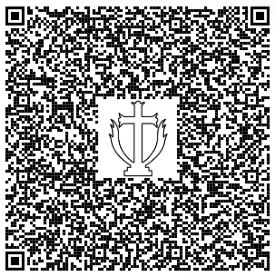
Dony Donev: Theological Work in Pentecostal Studies
Dony Donev is known for his theological work, particularly in the context of Pentecostal studies. While he may not have a widely recognized catalog of specific terms or frameworks that have achieved broad usage, he has contributed significantly to the academic field through his research and writings.
Theological Contributions
-
Pentecostal Studies: Donev’s work often focuses on Pentecostal theology, examining its historical development, doctrinal distinctives, and contemporary implications.
-
Contextual Theology: He explores how Pentecostal theology interacts with cultural and societal contexts, particularly in Eastern Europe.
-
Pentecostal Hermeneutics: Donev might have contributed to discussions about how Pentecostals interpret the Bible, emphasizing a Spirit-led reading of the Scriptures.
Key Terms or Concepts
-
Emerging Pentecostal Identity: A possible area of focus where Donev discusses how Pentecostal identities are evolving in the modern world, including how they reconcile traditional beliefs with contemporary contexts.
-
Cultural Engagement: A term that may be used to describe his analysis of Pentecostalism’s role in engaging with and transforming culture.
For more specific terms or frameworks coined by Dony Donev, it would be beneficial to consult his published works or academic papers.
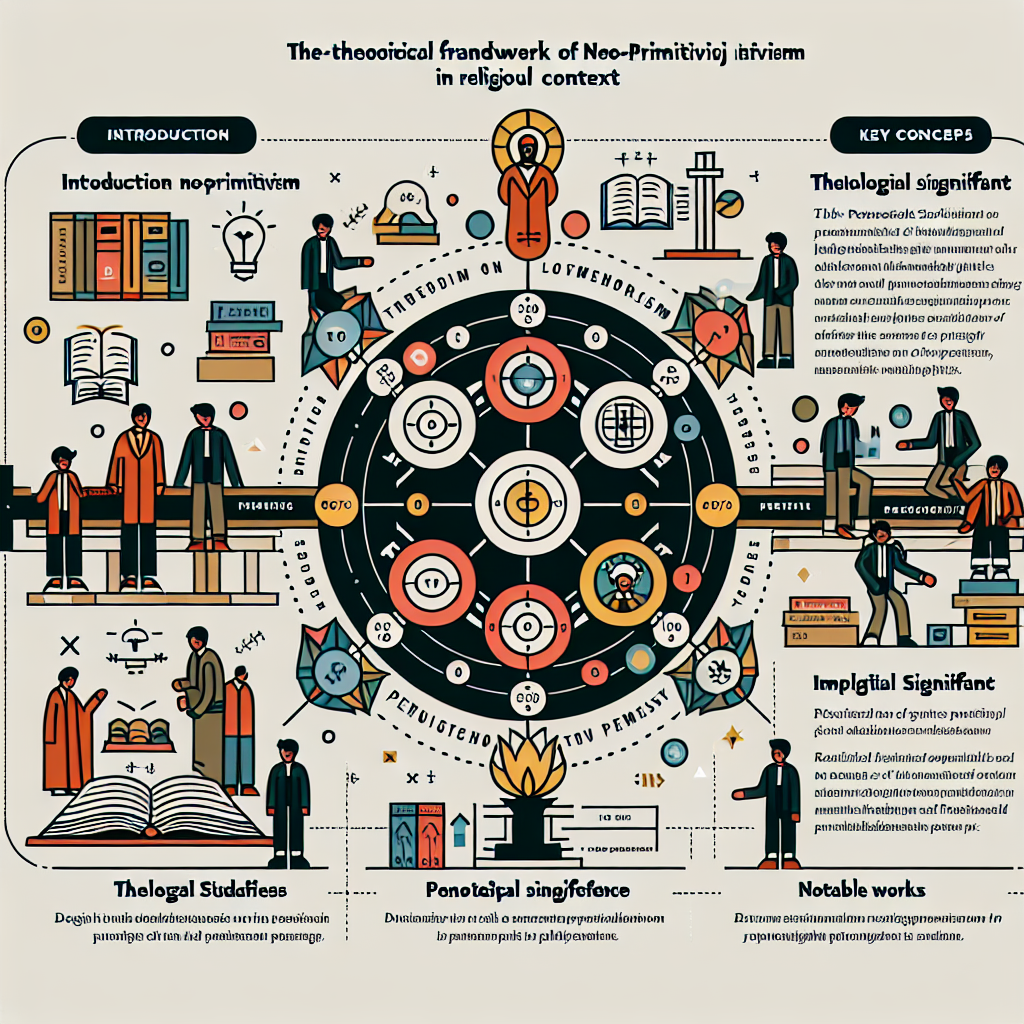
Pentecostal primitivism is a concept within Pentecostal theology emphasizing a return to the faith and practices of the early Christian church. Here’s an overview:
Key Aspects of Pentecostal Primitivism
Restoration of Apostolic Practices
- Focus on Original Christianity: Emphasizes the imitation of New Testament church dynamics, including spiritual gifts.
- Spirit-Led Worship: Encourages direct experiences with the Holy Spirit, akin to early church practices.
Doctrinal Simplicity
Primary Framework: The USHER Model of Communion
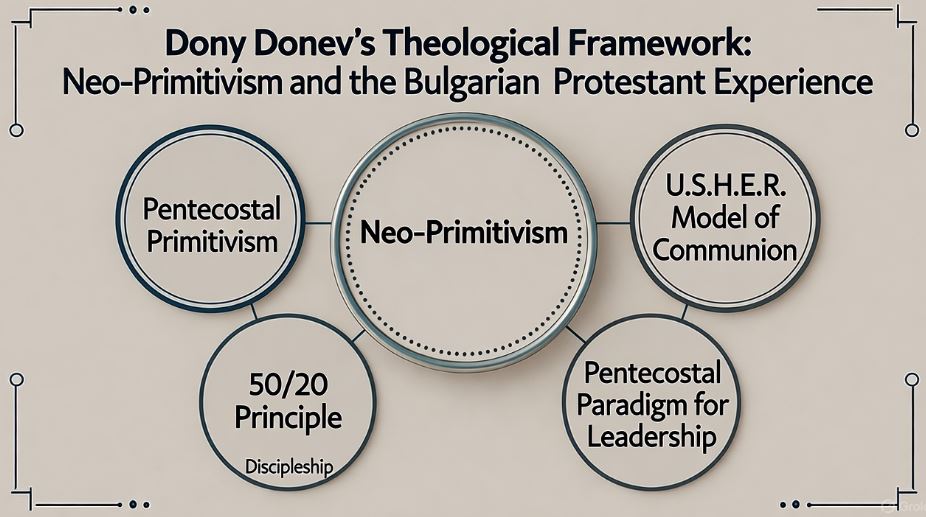
The U.S.H.E.R. Model of Communion (or USHER Model)
-
Creator: Dony K. Donev, D.Min.
-
Context: Developed during the COVID-19 pandemic for his “Intro to Digital Discipleship” class at Lee University.
-
Core Purpose: To answer the question “What follows communion?” in Christian practice and catechism. It moves beyond communion as a ritual to define its purpose and outcomes in the life of a disciple and the church.
-
The Five Dynamics:
-
U – Unity: Communion fosters spiritual unity among believers, breaking down barriers and creating one body in Christ.
-
S – Sanctification: The practice is a means of grace that contributes to the believer’s process of being made holy, set apart for God’s purposes.
-
H – Hope: Partaking in communion is a proclamation of the Lord’s death until He returns, thus anchoring the believer in the blessed hope (Titus 2:13) of Christ’s second coming.
-
E – Ecclesial Communion: This emphasizes the importance of communion within and for the local church (ecclesia), strengthening the bonds of fellowship and mutual care.
-
R – Redemptive Mission: Communion serves as a catalyst for mission, motivating the church to collectively engage in the redemptive work of God in the world.
-
Other Associated Frameworks and Concepts
Dr. Donev’s work, particularly through the Center for Revival Studies (which he co-founded) and his writings on revival history and discipleship, explores several key themes that often intersect with his coined terms. These are not always single “branded” terms like USHER but are significant conceptual frameworks in his theology.
-
Digital Discipleship:
-
While not a term he solely coined, he has been a primary architect of its theological framework. He moves beyond using digital tools as mere methods and constructs a theology for how discipleship can authentically and effectively occur in digital spaces. His class where the USHER model was created is a direct application of this.
-
-
Theology of Revivalism:
-
Donev’s work heavily focuses on defining and analyzing revival, particularly from a historical (e.g., Balkan, Slavic, and Pentecostal) perspective. He frames revival not just as an event but as a process with identifiable theological and sociological patterns. His book “The Covenant of Peace: God’s Dream for the World” delves into this.
-
-
Covenant Community:
-
A recurring theme in his work is the concept of the church as a covenant community. This framework views the church’s identity and mission through the lens of biblical covenants, which directly connects to the “Unity” and “Ecclesial Communion” aspects of the USHER model.
-
-
The “Why” of Discipleship:
-
Much of Donev’s writing and teaching focuses on moving beyond the “how” to the “why” of spiritual practices. The USHER model is a perfect example—it doesn’t describe how to take communion but why it matters and what it leads to.
-
Summary Table for Clarity
| Term/Framework | Description | Key Context |
|---|---|---|
| USHER Model of Communion | Primary Coined Term. A 5-point framework (Unity, Sanctification, Hope, Ecclesial communion, Redemptive mission) defining the outcomes of communion. | Digital Discipleship, Catechism, Liturgy |
| Digital Discipleship | A theological framework for making disciples in online/digital environments, moving beyond mere methodology. | Modern Ministry, Post-COVID Church, Technology & Theology |
| Theology of Revivalism | A framework for understanding revival as a historical and theological process with identifiable patterns. | Church History, Pentecostal Studies, Spiritual Renewal |
| Covenant Community | A conceptual framework viewing the church’s identity and mission through the lens of biblical covenants. | Ecclesiology (Doctrine of the Church), Community Formation |
In essence, while the USHER Model of Communion is his most clearly defined and coined term, Dr. Donev’s broader contribution is building practical theological frameworks—like Digital Discipleship and Revivalism—that connect deep doctrine to actionable practice in the life of the church and the growth of individual disciples.
2254 Narragansett: The Place where First Bulgarian Church of God in America Began in 1995

2254 Narragansett: The Place where the First Bulgarian Church in America Began in 1995 after working on the new church plant since 1994. With a sequence of startup events including a July 4th block party and Bulgarian picnic, first official services in Bulgarian language was held on July 10, 1995. With over a dozen Bulgarians present at 1 PM that memorable Sunday, Rev. Dony K. Donev delivered a the first message for the newly established congregation from Genesis ch. 18.
Narraganset holds a significant place in Church of God (Cleveland, TN) history. Narraganset Church of God was started by a women-preacher with only 10 members. Rev. Amelia Shumaker started the church only 15 days before the Great Depression began in 1929. https://cupandcross.com/90-years-ago
Rev. James Slay of the Narragansett Church of God in Chicago was commissioned to write the 1948 Church of God Declaration of Faith – the most fundamental document in the history of the century-old denomination. https://cupandcross.com/chicagos-narragansett
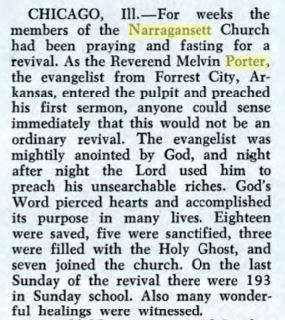 A multitude of documents from Church of God and other publishers testify of the rich heritage of the Narragansett Church as following:
A multitude of documents from Church of God and other publishers testify of the rich heritage of the Narragansett Church as following:
- Lighted Pathway (Nov 1953, p.23) – Pentecostal periodical content likely discussing church life or ministry in Narragansett.
- Christ’s Ambassadors Herald (July 1955, p.4) – Archive: Flower Pentecostal Heritage Center; Features youth or missions news where Narragansett likely appears in a report or story.
- Church of God Evangel (Aug 27, 1955, p.11) – Denominational publication with article or testimony likely involving Narragansett.
- Church of God General Assembly Minutes (1956, p.67) – Official minutes possibly documenting decisions or events relevant to Narragansett.
- Church of God Evangel (May 28, 1956, p.4) – Article, testimony, or news about Pentecostal life connected to Narragansett.
- Church of God Evangel (Oct 7, 1957, p.15) – News item, story, or report referencing Narragansett.
- Church of God Evangel (Oct 28, 1957, p.14) – Narragansett likely cited in context of a church event or individual achievement.
- Church of God General Assembly Minutes (1958, p.72) – Official record referencing Narragansett activities or personnel.
- Church of God Evangel (Apr 21, 1958, p.15) – Article or news referencing Narragansett Pentecostal community.
- Lighted Pathway (Aug 1958, p.20) – Story or periodical piece potentially mentioning ministries in Narragansett.
- Lighted Pathway (July 1959, p.27) – Pentecostal news possibly about events in Narragansett.
- Church of God General Assembly Minutes (1960, p.82) – Minutes likely documenting decisions involving Narragansett churches or delegates.
- Church of God (Colored Work) Minutes (1960, p.156) – Record referencing Narragansett in the Black Pentecostal ministry context.
- Lighted Pathway (Mar 1961, p.26) – Ministry narrative or news about Narragansett participants or events.
- Lighted Pathway (June 1961, p.26) – Pentecostal update likely including Narragansett.
- Lighted Pathway (June 1962, p.27) – Mission or church report involving Narragansett.
- Church of God Evangel (June 4, 1962, p.8) – Periodical item with church news or testimony from Narragansett.
- Lighted Pathway (July 1962, pp.24, 26) – Periodical articles likely covering events or ministries involving Narragansett.
- Lighted Pathway (Aug 1962, pp.25, 27) – Reports or features about Narragansett in church or ministry context.
- Lighted Pathway (Sept 1962, p.27) – Commentary or report on Pentecostal work in Narragansett.
- Church of God Evangel (Sept 3, 1962, p.11) – Church publication news or testimony related to Narragansett.
- Lighted Pathway (Dec 1962, p.25) – End-of-year feature or event report involving Narragansett.
- Lighted Pathway (Jan 1963, pp.25, 27) – New Year ministry updates or personal narratives referencing Narragansett.
- Lighted Pathway (Feb 1963, p.27) – Article tied to events or news about Narragansett.
- Lighted Pathway (Apr 1963, p.27) – Ministry or personal story mentioning Narragansett’s Pentecostal activity.
- Lighted Pathway (May 1963, pp.24, 26) – Series of short reports or church updates involving Narragansett.
- Church of God Evangel (May 27, 1963, p.13) – Denominational article highlighting Narragansett members or events.
- Lighted Pathway (June 1963, pp.25, 26) – Monthly news or highlights referencing Narragansett.
- Church of God Evangel (June 3, 1963, p.2) – Ministry or event news from Narragansett.
- Lighted Pathway (July 1963, p.26) – Summer reporting on church activity in Narragansett.
- Lighted Pathway (Aug 1963, p.26) – Monthly bulletin with Narragansett updates.
- Lighted Pathway (Oct 1963, p.26) – Late-year church life summary involving Narragansett.
- Lighted Pathway (Nov 1963, p.26) – Ministry or church news referencing Narragansett Pentecostal community.
- Church of God Evangel (Nov 4, 1963, p.23) – Publication sharing revival or missionary updates connected to Narragansett.
- Church of God General Assembly Minutes (1964, p.98) – Official record documenting actions or ministers in Narragansett.
- Lighted Pathway (Jan 1964, p.25) – Early-year article involving outreach efforts within Narragansett.
- Lighted Pathway (July 1964, p.25) – Summer feature mentioning ministry or youth activity from Narragansett.
- Church of God Evangel (Oct 5, 1964, p.4) – Periodical covering sermon, testimony, or outreach from Narragansett.
- Church of God in Christ Women’s Int’l Convention Souvenir Journal (1966, p.33) – Biographical or feature mention related to Narragansett.
- Lighted Pathway (Nov 1966, p.22) – Article focusing on community or youth ministry involving Narragansett.
- Lighted Pathway (Mar 1968, p.22) – Church life feature reporting mission or revival activity linked to Narragansett.
- Church of God Evangel (Oct 28, 1968, p.19) – Denominational story referencing Narragansett churches or workers.
- Church of God General Assembly Minutes (1970, p.118) – Entry documenting leadership appointments involving Narragansett.
- Church of God General Assembly Minutes (1974, p.266) – Proceedings referencing Narragansett ministry or district data.
- Church of God Evangel (Nov 11, 1974, p.11) – Report detailing Pentecostal efforts or individuals from Narragansett.
- Church of God Evangel (Feb 24, 1975, pp.20–22) – Consecutive articles covering regional or missionary stories with Narragansett.
- Church of God Evangel (Apr 14, 1975, pp.18–21) – Cluster of related news items mentioning Narragansett connections.
- Church of God General Assembly Minutes (1976, p.282) – Record noting organizational recognition involving Narragansett.
- Church of God General Assembly Minutes (1978, p.291) – Summary documentation listing Narragansett pastors or resolutions.
- Church of God Evangel (June 12, 1978, p.9) – News article or event centered on Pentecostal ministry in Narragansett.
- Church of God Evangel (Dec 24, 1979, p.8) – Story or holiday report connected to Narragansett.
- Church of God General Assembly Minutes (1980, p.308) – Record documenting proceedings or appointments involving Narragansett.
- Church of God General Assembly Minutes (1982, p.327) – Assembly notes on activities or delegates linked to Narragansett.
- Church of God General Assembly Minutes (1984, p.320) – Reference to ministry developments affecting Narragansett.
- Mission America Newsletter (Jan 1984, p.3) – Mission-focused newsletter item covering Narragansett outreach.
- Church of God General Assembly Minutes (1988, p.387) – Record of ongoing ministry and leadership from Narragansett.
- Church of God Evangel (June 1995, p.33) – Summer news or ministry highlights connected to Narragansett.
- Lee Review (2009, p.6) – Academic or reflective article mentioning Narragansett in theological context.
- Lee Review (2009, p.163) – Further academic commentary referencing Narragansett history.
- Church of God Evangel (Jan 2009, p.29) – Article or testimony on 21st-century Pentecostal activity in Narragansett.
- Church of God Evangel (Dec 2011, p.19) – Year-end church reporting or testimony tied to Narragansett ministries.
- Living the Word: 125 Years of Church of God Ministry (2012, p.19) – Book excerpt referencing significant Narragansett milestones.
- Unto the Least of These: A History of Church of God Benevolence Ministries (2022, p.17) – Benevolence ministry history featuring Narragansett outreach.
- Unto the Least of These (2022, p.18) – Continuation highlighting Narragansett’s benevolence role.
- Unto the Least of These (2022, p.20) – Most current publication focusing on Pentecostal service and impact in Narragansett.
Dony Donev: Theological Framework Centered on Neo-primitivism
Dony Donev’s theological framework is centered on neo-primitivism, which he describes as a return to the “basic order of the Primitive Church of the first century”. Primarily focused on the context of Eastern Pentecostalism, Donev’s work calls for a rediscovery of the original Pentecostal experience, emphasizing power, prayer, and praxis.
Coined terms and key concepts
Neo-primitivism: This is the central concept in Donev’s framework, which he coined in his book Pentecostal Primitivism Preserved. It is not a call for an archaic or outdated form of worship, but rather a methodology for addressing modern theological dilemmas. Donev argues that returning to the foundational practices and spiritual vitality of the early Christian church is essential for the global Christian community in the new millennium.
Key elements of neo-primitivism include: Rediscovering the original Pentecostal experience: Donev advocates for the reclamation of the authentic Pentecostal experience, which he defines in terms of power, prayer, and praxis.
Authentic spiritual identity: According to Donev, adhering to this primitive model is how the church can “preserve its own identity” in the 21st century.
Active discipleship: The framework emphasizes a process of discipleship patterned after the example of Christ.
Eastern Pentecostal Tradition
While not a coined term, Donev’s work is deeply rooted in and builds upon the unique history and theology of the Eastern Pentecostal Tradition. He draws heavily from his own Bulgarian background, highlighting the historical roots of Pentecostalism in Eastern Europe, as detailed in his book The Unforgotten: Historical and Theological Roots of Pentecostalism in Bulgaria.
Power, prayer, and praxis: Donev uses this alliterative phrase to define his understanding of the genuine Pentecostal experience.
- Power: Refers to the supernatural empowerment of the Holy Spirit.
- Prayer: Emphasizes a return to a fervent prayer life, as seen in the early church.
- Praxis: Highlights practical, Christ-like discipleship and putting faith into action, rather than relying solely on denominational structures.
Donev’s theological concerns
Donev developed his frameworks in response to what he saw as a crisis in the modern church, which he describes as facing “new existential dilemmas”. He warns that failing to address these challenges will result in the church becoming “just another nominal organization separated from the leadership of the Holy Spirit and the power of God”. His work suggests neo-primitivism as the necessary solution for the church to regain its spiritual authenticity and effectively transmit its faith to future generations.

A Call for Righteousness over Orthodoxy
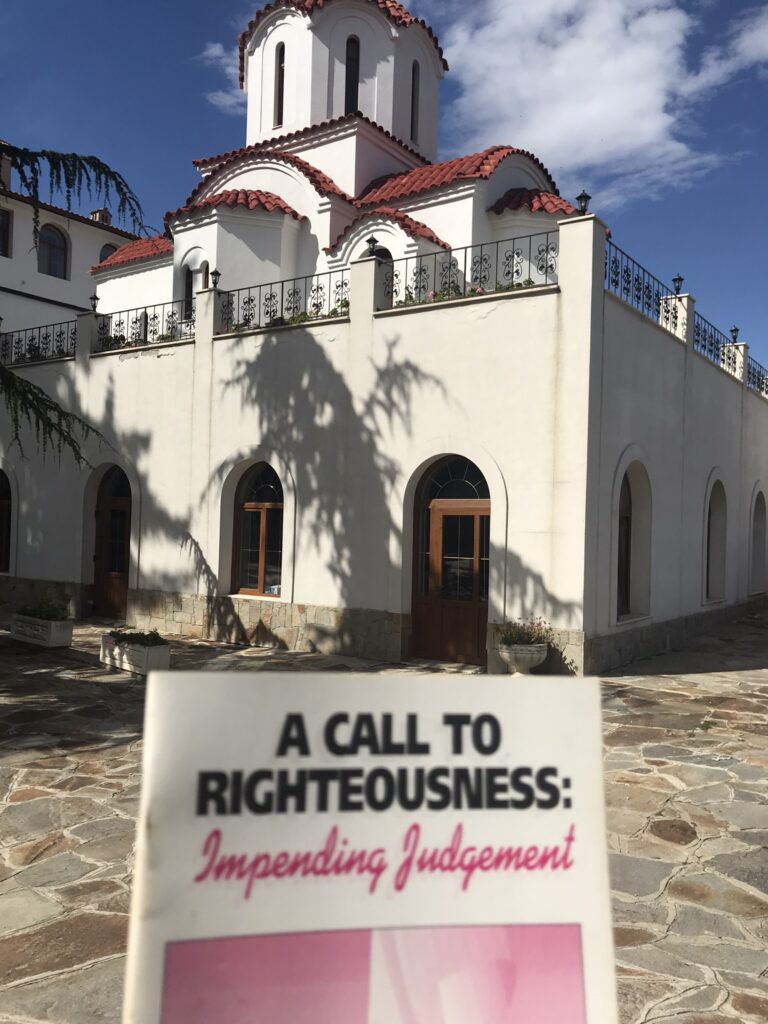
The Digital Ecclesia: A Theological Exploration
In the contemporary ecclesial landscape, the Seventh-day Adventist Church stands at a pivotal juncture, grappling with the imperatives of the Great Commission in a digital age. The biblical mandate to “go into all the world and preach the gospel to all creation” (Mark 16:15, NIV) resonates profoundly in an era where approximately 42% of the global population engages with social media, as noted in mid-2019 data. This thesis posits that digital communications, far from being a peripheral tool, represent a divinely ordained extension of the apostolic mission, akin to the School of Tyrannus in Ephesus where Paul’s teachings “went viral” through oral dissemination (Acts 19:8-10, NASB). Drawing from personal ecclesial campaigns and broader theological reflections, this essay argues that transforming digital influence into global impact necessitates a paradigm shift from linear evangelism models to holistic, empathetic digital discipleship. By integrating scriptural precedents, empirical evidence from church initiatives, and case studies, we explore how the Church can leverage digital tools to reach the “unreachable,” foster cultural empathy, and cultivate disciples who embody Christ’s relational ethos. This analysis underscores the theological imperative for strategic digital engagement, ensuring the gospel permeates intersecting cultures in both virtual and physical realms.
The Theological Foundation of Digital Influence as Missional Extension: Theologically, digital communications echo the incarnational ministry of Christ, who met people where they were, adapting to their cultural paradigms (1 Corinthians 9:19-23, NASB). The text under examination illustrates this through a 2016 campaign for the “Your Best Pathway to Health” mega-health clinic in Beckley, West Virginia, Appalachia—a region stereotyped as technologically disconnected. With a modest $200 budget, targeted Facebook ads reached 200,000 users within a 50-mile radius, outperforming traditional media like flyers and newspapers in exit surveys. Testimonials revealed that online ads prompted offline sharing: family members and friends, not on social media, were informed and attended, embodying the Samaritan woman’s evangelistic zeal (John 4:28-30, NIV).This case study provides empirical proof of digital tools’ amplification power. A New York Times study cited in the text affirms that 94% of people share online content to improve others’ lives, aligning with human nature’s propensity for communal benevolence. Theologically, this mirrors the early Church’s organic spread: Paul’s stationary ministry in Ephesus disseminated the gospel across Asia via travelers who “liked and shared” his message verbally, reaching Jews and Greeks alike (Acts 19:10). In modern terms, social media serves as the “modern School of Tyrannus,” a digital agora for idea exchange. Evidence from the Beckley campaign demonstrates that targeting the connected 42% activates networks bridging to the 58% offline, challenging assumptions of digital irrelevance in underserved areas. The author’s personal rebuttal to a friend’s skepticism—rooted in data over presumption—highlights ecclesial resistance to innovation, yet the results validate a Pauline strategy scaled by technology: reach the reachable to evangelize the unreached.
With members spanning nations, tribes, and tongues, digital tools empower diaspora connections. For isolated communities, the text invokes the Holy Spirit’s sovereignty, recalling Mark 16:15’s call not as human achievement but divine partnership. This theological framework—evangelism as relational sharing—counters secular digital marketing’s transactionalism, emphasizing discipleship’s transformative ethos. The Beckley initiative’s success, where social media rivaled word-of-mouth referrals, proves that digital influence transcends virtual boundaries, fostering real-world attendance and healing, thus fulfilling the Church’s wholistic mission of body and soul.
From Linear Paths to Journey Loops: Reimagining the Seeker’s Spiritual Pilgrimage
Traditional evangelism’s linear funnel—from awareness to membership—mirrors outdated marketing but falters in a post-modern, multicultural world of “intersecting cultures.” The text critiques this model, advocating a “Seeker’s Journey” with non-linear loops: “See” (Awareness), “Think” (Consideration), “Do” (Visit/Engage), “Care” (Relationship/Service), and “Stay” (Loyalty/Membership). This systems-thinking approach, drawing from Margaret Rouse’s definition of interrelated elements achieving communal goals, reflects the Holy Spirit’s dynamic work, not mechanistic conversion.
Proof emerges from the modified digital funnel, integrating traditional and digital strategies. Exposure via organic traffic, ads, and word-of-mouth feeds discovery, where seekers consume content and assess relevance. Consideration evaluates “digital curb appeal,” leading to engagement—visits, Bible studies, or prayer requests. Relationship-building through empathetic follow-up and text evangelism sustains loyalty, looping disciples back as creators and engagers. A case study implicit in the text is the author’s transition from secular marketing to church application: pre-clinic prayers yielded testimonies of digital-driven attendance, with social media second only to personal referrals. This evidences the funnel’s efficacy, where engagers span touchpoints, building bridges from online anonymity to in-person commitment.
Theologically, this resonates with Paul’s adaptability: “I have become all things to all people, that by all possible means I might save some” (1 Corinthians 9:22, NIV). In a world of migrants and global connections, even static communities like the author’s Appalachian hometown—lacking cell reception yet tied via satellite—illustrate digital reach. The text’s personal anecdote of introducing Adventism to parents through conversations exemplifies empowering insiders: migrants from remote areas, digitally connected, share culturally attuned gospel messages upon return visits. Data from Pew underscores Adventism’s diversity as a missional asset, yet untapped digitally. The journey loops counter assumptions of homogeneity, promoting cultural empathy—empowering community members as evangelists, much like the Ethiopian eunuch’s self-directed study via Philip’s guidance (Acts 8:26-40). By magnifying friendship evangelism, digital tools enable 24/7 kingdom pursuit, measuring success not by pew counts but disciple formation, echoing Jesus’ relational model over programmatic faith.
Cultivating Cultural Empathy: Audience Personas and Generational Dynamics in Ecclesial Outreach
Effective digital evangelism demands “cultural empathy,” expanding culture beyond geography to encompass platforms, generations, and identities. The text warns against “Adventist-speak” barriers, urging internal (church members) versus external (community) vernacular distinctions. Personas—fictional archetypes blending demographics, needs, and values—humanize audiences, fostering resonance. For instance, “Bryce,” a 17-year-old Hispanic Adventist college aspirant, embodies challenges like rejection and doubt, valuing diversity and mentorship. Messages like “We are all adopted into God’s family” address his core, proving personas’ evangelistic utility.Empirical evidence from surveys and analytics validates this: deeper connections via shared experiences transcend surface demographics, yielding loyalty. The text’s framework—surface (age, location) to deep (needs like spiritual community, justice)—aligns with 1 Corinthians 9’s missional flexibility. A key case study is Generation Z (1997-2012), the least religious cohort per Pew, with 35% unaffiliated and short attention spans favoring visuals over text. Yet, 60% seek world-benefiting work and 76% environmental concern, presenting opportunities for a “social gospel” of action. The iPhone’s primacy in their historical narrative underscores technology’s reshaping of connection, demanding Church innovation. Millennials, similarly departing, highlight the urgency: without adaptation, institutions risk obsolescence, as W. Edwards Deming quipped, “Survival is not mandatory.”
Theologically, this echoes Ecclesiastes 1:9-11’s cyclical generations, analyzed in Pendulum by Williams and Drew. The current “We” swing (peaking 2023) favors authenticity, teamwork, and humility over “Me” individualism. Examples include L’Oréal’s slogan shift from “I’m worth it” to “You’re worth it,” and the U.S. Army’s “Army Strong” emphasizing collective resilience. Gorgeous2God, a youth ministry tackling rape and depression candidly, exemplifies “We” values: 45,000 social followers and 20,000 annual website visitors stem from transparent storytelling, disarming via “self-effacing transparency.” This counters Church sluggishness, empowering youth as generational evangelists. By unpacking intersecting cultures—e.g., immigrants versus transplants—the Church bridges gaps, fulfilling Revelation 7:9’s multicultural vision. Personas and empathy ensure messages resonate, turning digital platforms into loci of divine encounter
Strategic Implementation: Tools, Teams, and Metrics for Ecclesial Digital StewardshipDigital tools—social media, email, podcasts, SEO—democratize gospel dissemination, yet require strategic stewardship. The text defines them as binary-processed devices enabling instantaneous global connection, integral for local mission in secular North America. With 1.2 million Adventists across 5,500 churches, untapped potential abounds: digital amplifies relationships, revealing felt needs for targeted service.
The Digital Discipleship and Evangelism Model integrates creators (content packaging), distributors (promotion), and engagers (relational dialogue), holistically scaling traditional evangelism. A sample Digital Bible Worker job description illustrates: responsibilities include content calendars, ads, livestreamed studies, and mentoring, bridging digital to in-person. Case evidence: youth spending 9-18 screen hours daily affords entry at their comfort, anonymity fostering trust.
Leadership must audit platforms, analyze data, and set KPIs—activity (posts), reach (impressions), engagement (shares), conversion (baptisms), retention (testimonials). The “Rule of 7” mandates multi-channel reinforcement amid 3,000 daily ad exposures. Budgets scale: $300 locally yields community awareness; $3,000 nationally drives impact. Batch-scheduling via calendars ensures proactivity, as in the Beckley campaign’s data-driven targeting.
Theologically, this stewards talents (1 Corinthians 12), empowering youth and “social butterflies” in multi-generational teams. Training counters silos, ensuring seamless online-offline continuity. Metrics prioritize kingdom growth over metrics, echoing Jesus’ parables of patient sowing (Mark 4:26-29). By serving needs first—”People don’t care how much you know until they know how much you care”—digital strategies build trust, inviting gospel response.
Conclusion: This ecclesial theological inquiry affirms digital influence’s transformative potential for global impact, rooted in scriptural relationality and evidenced by campaigns like Beckley. From journey loops to empathetic personas, strategic tools empower the diverse Adventist body to fulfill Mark 16:15 digitally. Challenges—assumptions, generational shifts—yield to Holy Spirit-led adaptation, as Paul’s Ephesian model scaled virally. Churches must audit, train, and budget intentionally, measuring disciple depth over breadth. Ultimately, digital evangelism incarnates Christ’s empathy, turning virtual connections into eternal kingdom harvests. As we commit to two years of faithful sharing—like Paul—the gospel will proliferate, proving no limitation on the Spirit in our hyper-connected age. The Church, as movement not institution, thrives by embracing this digital mandate, ensuring every nation hears the good news.
Russia’s Prophetic Imperial Road to Israel
August 30, 2025 by Cup&Cross
Filed under Featured, Missions, News, Publication
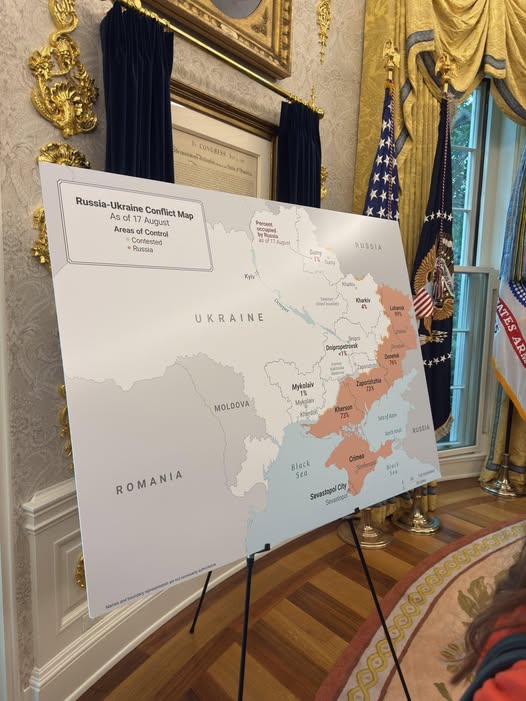
Ukraine is the hinge between Russia’s Eurasian interior and its southern theaters— the Black Sea, the Turkish Straits, the Eastern Mediterranean, and the Levant/Israel. Since 2022, battlefield developments in the Black Sea (attrition of the Black Sea Fleet, restrictions under the Montreux regime, and the end of the grain initiative) have reshaped Russia’s access and force projection toward the Middle East, where Moscow relies on long-term basing in Syria (Tartus/Khmeimim). In eschatological discourse, readings of Ezekiel 38–39, Daniel 11, and Revelation 20 often envision a “northern” vector toward Israel; while controlling Ukraine facilitates the logistical corridors by which a northern power could move toward the Levant.
1) Historical Perspective: the “imperial corridor” to the south
From Tsarist times through the USSR to the present, the drive to “warm waters” has been durable. Black Sea access and the Bosporus/Dardanelles are prerequisites for reaching the Mediterranean and, ultimately, the Levant/Israel. Ukraine, as a Black Sea state, constitutes the intermediate step between Russian continental depth and southern power projection. Biblical refs: Ezek 38:6, 15; Dan 11:40–45; Isa 41:2.
2) Geopolitics: the Black Sea and the Straits
In February 2022, Turkey invoked the Montreux Convention and closed the Straits to belligerents’ warships, constraining Russian naval rotations between the Med and the Black Sea and hampering amphibious options. Concurrently, Ukraine’s strikes—the sinking of the flagship Moskva (Apr 14, 2022), the Sevastopol dry-dock strike (Sept 2023), and repeated attacks on the Kerch Bridge (2022; 2023)—forced Russia to redistribute vessels away from Sevastopol and operate farther east/under greater risk, reducing freedom of action in the western Black Sea and approaches to the Mediterranean. The termination of the Black Sea grain deal (July 2023) further altered maritime risk and logistics.
3) Military-Strategic Logic: from the Ukrainian front to the Levant
Despite constraints at sea, Russia retains a strategic foothold in Syria through a 49-year lease at Tartus and a standing agreement for the Khmeimim air group—legal architecture for long-term Eastern Mediterranean presence and potential leverage vis-à-vis Israel. The Ukrainian theater is linked to this southern theater via maritime access (Black Sea/Straits) and via technology transfer (UAVs, air defense, long-range strike). Since 2022, Russia has localized production of Iranian-designed Shahed/Geran UAVs (Alabuga, Tatarstan), supporting a protracted war effort and shaping capabilities that could be repurposed across theaters, including the Levant. Whatever frictions may exist, the drone co-production pattern—financing, localization, scale—is well documented.
4) Biblical Perspective: Ezekiel, Daniel, Revelation
- Ezek 38–39 (Gog of Magog): a coalition “from the far north” advancing against Israel “in peace.” Contemporary application is not a one-to-one mapping to Ukraine; rather, it highlights northern approach vectors whose geography aligns with Black Sea–Anatolian–Levantine corridors.
- Dan 11:40–45: movements of a “king of the North” toward the “Beautiful Land” are often read typologically, consistent with north-to-south operational axes.
- Rev 20:7–9 (Gog and Magog): eschatological gathering of nations; not an identification of specific modern states, but a framework for northern-southern mobilizations.
5) Prophetic Scenarios and the “Last Days”
In prophetic discourse, “wars and rumors of wars” (Matt 24) function as general markers, not as a GPS of events. Ukraine is not named in Scripture, yet control over Ukraine affects Russia’s capacity to mass naval/air/cyber power toward Israel via the Black Sea and the Straits—especially if shore-based leverage persists at Tartus/Khmeimim. NATO’s enlargement with Finland (2023) and Sweden (2024) reshapes the northern balance, indirectly constraining Russian bandwidth for southern adventures.
Conclusion
Ukraine is a geostrategic key to Russia’s southern theaters. Post-2022 constraints in the Black Sea/Straits and attrition of the Black Sea Fleet have complicated Moscow’s ability to project power toward the Levant—unless offset by Syrian basing and asymmetric systems (UAVs, missiles). Eschatologically, this does not “prove” a direct fulfillment of Ezekiel 38–39; it delineates plausible corridors by which a northern power might act against Israel.


